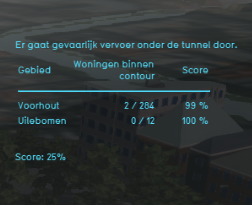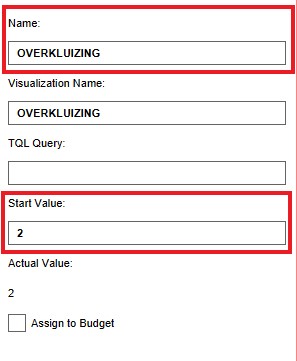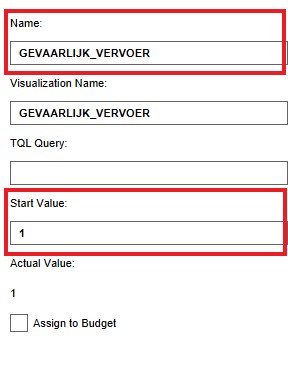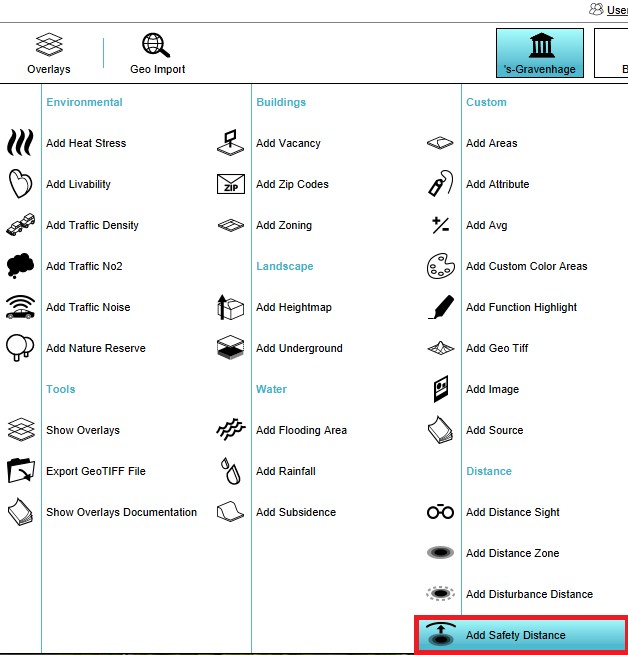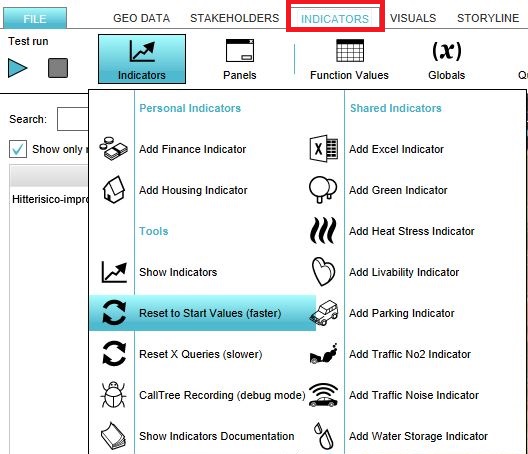Risk contour (Indicator): Difference between revisions
No edit summary |
|||
| Line 3: | Line 3: | ||
==General== | ==General== | ||
===What is the Safety Indicator?=== | ===What is the Safety Indicator?=== | ||
The Safety indicator calculates the number of | The Safety indicator calculates the number of houses that lie in a zone around a dangerous [[Construction]] and the houses that are outside this contour and therefore "safe". The indicatore calculates a risk score per neighborhood based on this ratio. The zones around dangerous constructions come from the Safety Distance Overlay. This overlay combines information from Risicokaart (to know where dangerous constructions are, for example a gas station) with a buffer size defined in the function values table for each dangerous function.<br> | ||
<br clear=all> | <br clear=all> | ||
| Line 10: | Line 10: | ||
The indicator panel (see the image on the right) shows in a table per [[Neighborhoods|neighborhood]]: | The indicator panel (see the image on the right) shows in a table per [[Neighborhoods|neighborhood]]: | ||
* the neighborhood name | * the neighborhood name | ||
* the number of houses in the | * the number of houses in the dangerous zone/ total number of houses | ||
* the | * the calculated risk score | ||
===Calculation=== | ===Calculation=== | ||
The risk score is a percentage calculated by retrieving the number of houses in the dangerous zone substracted from the total number of houses in the neighborhood. | |||
Then the number of safe houses is divided from the overall number of houses for that neighborhood. | |||
===Score=== | ===Score=== | ||
The score is represented in a progress bar, with a scale from 0 to 100%. Determine if you want to calculate the [[Indicators#Absolute_score|absolute or relative score]]. | The score is represented in a progress bar, with a scale from 0 to 100%. Determine if you want to calculate the [[Indicators#Absolute_score|absolute or relative score]]. | ||
The more houses are located in | The more houses are located in a zone around a dangerous construction, the lower the score. and the more risk there is. | ||
==Additional configurations== | ==Additional configurations== | ||
For this indicator to function, two global variables need to be added to the project, namely the global variable OVERKLUIZING and the global variable GEVAARLIJK_VERVOER. Also the [[ | For this indicator to function, two global variables need to be added to the project, namely the global variable OVERKLUIZING and the global variable GEVAARLIJK_VERVOER. Also the [[Safety_Distance_(Overlay)|Safety Distance Overlay]] has to be added to the project, see below for the steps. | ||
=== Add the Global Variables=== | === Add the Global Variables=== | ||
| Line 40: | Line 35: | ||
===Add the Safety Distance Overlay=== | ===Add the Safety Distance Overlay=== | ||
When the indicator is added to the project, an error message can be given. This is due to the missing [[ | When the indicator is added to the project, an error message can be given. This is due to the missing [[Safety_Distance_(Overlay)|Safety Distance Overlay]] in the project. Read below on how to add this overlay to the project. | ||
{{Editor steps|title=|Select in the editor 'Geo Data' from the ribbon|Select 'Overlays' from the ribbon bar|Select the [[ | {{Editor steps|title=|Select in the editor 'Geo Data' from the ribbon|Select 'Overlays' from the ribbon bar|Select the [[Safety_Distance_(Overlay)|Safety Distance Overlay]] from the drop down menu|Click on the tab Indicators and the button Indicators and choose for Reset to Start values (faster) to update your project.}} | ||
<gallery mode=nolines> | <gallery mode=nolines> | ||
File:Add_safety_distance_overlay.jpg | File:Add_safety_distance_overlay.jpg | ||
File:Reset.JPG | File:Reset.JPG | ||
</gallery> | </gallery> | ||
Revision as of 14:34, 14 March 2019
General
What is the Safety Indicator?
The Safety indicator calculates the number of houses that lie in a zone around a dangerous Construction and the houses that are outside this contour and therefore "safe". The indicatore calculates a risk score per neighborhood based on this ratio. The zones around dangerous constructions come from the Safety Distance Overlay. This overlay combines information from Risicokaart (to know where dangerous constructions are, for example a gas station) with a buffer size defined in the function values table for each dangerous function.
Indicator panel
The indicator panel (see the image on the right) shows in a table per neighborhood:
- the neighborhood name
- the number of houses in the dangerous zone/ total number of houses
- the calculated risk score
Calculation
The risk score is a percentage calculated by retrieving the number of houses in the dangerous zone substracted from the total number of houses in the neighborhood. Then the number of safe houses is divided from the overall number of houses for that neighborhood.
Score
The score is represented in a progress bar, with a scale from 0 to 100%. Determine if you want to calculate the absolute or relative score. The more houses are located in a zone around a dangerous construction, the lower the score. and the more risk there is.
Additional configurations
For this indicator to function, two global variables need to be added to the project, namely the global variable OVERKLUIZING and the global variable GEVAARLIJK_VERVOER. Also the Safety Distance Overlay has to be added to the project, see below for the steps.
Add the Global Variables
- Select in the editor 'Indicators' from the ribbon
- Select 'Globals' from the ribbon bar
- Select Add Global from the drop down menu
- Write the name OVERKLUIZING in the Name field on the right panel
- Write the value 2 in the Start Value field on the right panel
- Notice that a new global variable with the name OVERKLUIZING is added to the list of global variabels on the left panel.
- Select in the editor 'Indicators' from the ribbon
- Select 'Globals' from the ribbon bar
- Select Add Global from the drop down menu
- Write the name GEVAARLIJK_VERVOER in the Name field on the right panel
- Write the value 2 in the Start Value field on the right panel
- Notice that a new global variable with the name GEVAARLIJK_VERVOER is added to the list of global variabels on the left panel.
Add the Safety Distance Overlay
When the indicator is added to the project, an error message can be given. This is due to the missing Safety Distance Overlay in the project. Read below on how to add this overlay to the project.
- Select in the editor 'Geo Data' from the ribbon
- Select 'Overlays' from the ribbon bar
- Select the Safety Distance Overlay from the drop down menu
- Click on the tab Indicators and the button Indicators and choose for Reset to Start values (faster) to update your project.
